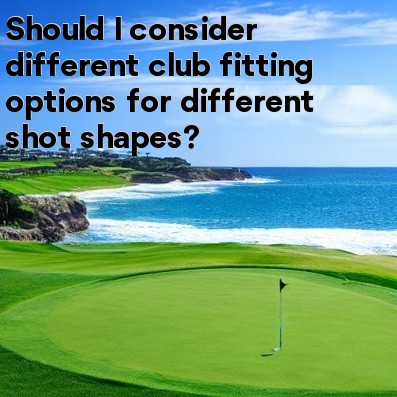
Should I consider different club fitting options for different shot shapes?
Golf is a game that requires precision and skill. Every golfer aims to hit the ball straight and achieve the desired shot shape. However, many golfers struggle with consistency and find themselves hitting shots that deviate from their intended shape. One factor that can significantly impact shot shape is club fitting.
Club fitting is the process of customizing golf clubs to match a golfer's unique swing characteristics. It involves analyzing various factors such as swing speed, ball flight, and shot shape to determine the optimal club specifications. While some golfers may believe that one club fitting is sufficient for all shot shapes, others argue that different shot shapes may require different club fitting options.
- Draw Shots: A draw shot is one that curves from right to left (for right-handed golfers). To hit a draw, golfers generally need a closed clubface at impact. Therefore, a club fitting for draw shots may involve adjusting the clubface angle to a closed position. Additionally, the lie angle may be adjusted to counteract any potential hooks. A golfer who frequently hits draw shots may benefit from these specific club fitting options.
- Fade Shots: A fade shot is one that curves from left to right (for right-handed golfers). To hit a fade, golfers generally need an open clubface at impact. In club fitting for fade shots, the clubface angle may be adjusted to an open position. Furthermore, the lie angle may be modified to help prevent the clubface from closing too much, reducing the chance of hooks. Golfers who often hit fade shots may find these club fitting options advantageous.
- Straight Shots: Straight shots are the ideal shots that every golfer aims for. Club fitting for straight shots typically involves adjusting the clubface angle to a neutral position and ensuring the lie angle is appropriate for the golfer's swing. While some golfers may argue that one club fitting for straight shots is adequate, others argue that subtle variations in shot shape may still require specific club fitting options.
It's important to note that these club fitting options are not absolute. Golfers may have individual preferences and unique swing characteristics that influence the club fitting process. Therefore, it is always recommended to consult with a professional club fitter who can analyze your swing and provide personalized recommendations.
Furthermore, improving consistency in shot shape can also be achieved through practice and proper technique. While club fitting can help optimize performance, it is not a magic solution. Golfers should invest time in developing a repeatable swing to consistently produce the desired shot shape.
In conclusion, considering different club fitting options for various shot shapes can be beneficial for golfers looking to improve consistency and optimize performance. Adjusting clubface and lie angles to match the intended shot shape can help golfers achieve the desired results. However, individual preferences and unique swing characteristics should also be taken into account. Consult with a professional club fitter to ensure the best club fitting options for your game.





